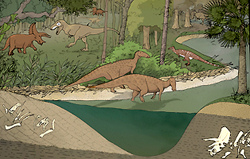Magma can survive in upper crust for hundreds of millennia
Reservoirs of silica-rich magma – the kind that causes the most explosive volcanic eruptions – can persist in Earth’s upper crust for hundreds of thousands of years without triggering an eruption, according to new University of Washington modeling research.
That means an area known to have experienced a massive volcanic eruption in the past, such as Yellowstone National Park, could have a large pool of magma festering beneath it and still not be close to going off as it did 600,000 years ago.
“You might expect to see a stewing magma chamber for a long period of time and it doesn’t necessarily mean an eruption is imminent,” said Sarah Gelman, a UW doctoral student in Earth and space sciences. (more…)

